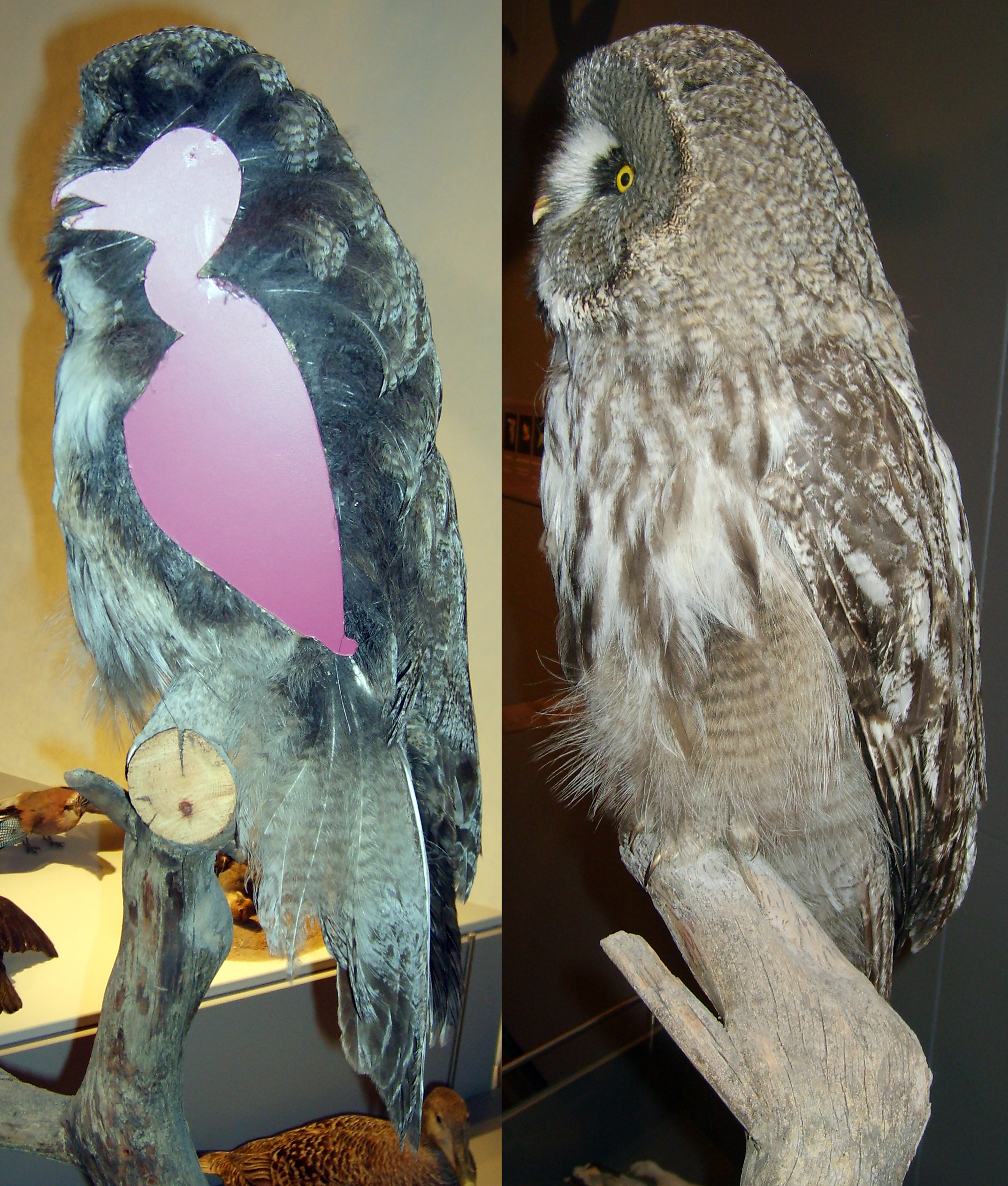|
Pernambuco Pygmy Owl
The Pernambuco pygmy owl (''Glaucidium mooreorum'') is a species of owl in the family Strigidae. This species, first described in 2002, is endemic to Pernambuco state in Brazil. Taxonomy and systematics The Pernambuco pygmy owl was first described in December 2002 when two study skins were examined. The skins were originally collected in 1980 and thought to be subspecies of the East Brazilian pygmy owl (''Glaucidium minutissimum'') or Amazonian pygmy owl (''G. hardyi''). Upon closer examination of the skins, and vocalizations of the species recorded in 1990, it was concluded that it was a new species.Fjeldså, J. and C. J. Sharpe (2020). Pernambuco Pygmy-Owl (''Glaucidium mooreorum''), version 1.0. In Birds of the World (J. del Hoyo, A. Elliott, J. Sargatal, D. A. Christie, and E. de Juana, Editors). Cornell Lab of Ornithology, Ithaca, NY, USA. https://doi.org/10.2173/bow.perpyo1.01 retrieved September 6, 2021 It was suggested that the type specimen of the East Brazilia ... [...More Info...] [...Related Items...] OR: [Wikipedia] [Google] [Baidu] |
Strigidae
The true owls or typical owls (family Strigidae) are one of the two generally accepted families of owls, the other being the barn owls (Tytonidae). This large family comprises 230 living or recently extinct species in 24 genera. The typical owls have a cosmopolitan distribution and are found on every continent except Antarctica. Morphology While typical owls (hereafter referred to simply as owls) vary greatly in size, with the smallest species, the elf owl, being a hundredth the size of the largest, the Eurasian eagle-owl and Blakiston's fish owl, owls generally share an extremely similar body plan.Marks, J. S.; Cannings, R.J. and Mikkola, H. (1999). "Family Strigidae (Typical Owls)". ''In'' del Hoyo, J.; Elliot, A. & Sargatal, J. (eds.) (1999). ''Handbook of the Birds of the World. Volume 5: Barn-Owls to Hummingbirds.'' Lynx Edicions. They tend to have large heads, short tails, cryptic plumage, and round facial discs around the eyes. The family is generally arboreal (with ... [...More Info...] [...Related Items...] OR: [Wikipedia] [Google] [Baidu] |
Bird Species New To Science Described In The 2000s
This page details the bird species described as new to science in the years 2000 to 2010: Summary statistics Number of species described per year Countries with high numbers of newly described species * Brazil * Colombia * Peru * Indonesia The birds, year-by-year 2000 * Foothill elaenia, ''Myiopagis olallai'' :Coopmans, P. & Krabbe, N. (2000) A new species of flycatcher (Tyrannidae: Myiopagis) from eastern Ecuador and eastern Peru ''Wilson Bulletin'' 112: 305–312 * Caatinga antwren, ''Herpsilochmus sellowi'' :Whitney, B.M.; Pacheco, J.F.; Buzzetti, D.R.C. & Parrini, R. (2000) Systematic revision and biogeography of the Herpsilochmus pileatus complex, with description of a new species from northeastern Brazil ''Auk'' 117: 869–891 * Taiwan bush-warbler, ''Bradypterus alishanensis'' :Rasmussen, P.C.; Round, P.D.; Dickinson, E.C. & Rozendaal, F.G. (2000) A new bush-warbler (Sylviidae, Bradypterus) from Taiwan ''The Auk'' 117: 279–289 * Scarlet-banded barbet or Wallac ... [...More Info...] [...Related Items...] OR: [Wikipedia] [Google] [Baidu] |
Endemic
Endemism is the state of a species being found in a single defined geographic location, such as an island, state, nation, country or other defined zone; organisms that are indigenous to a place are not endemic to it if they are also found elsewhere. For example, the Cape sugarbird is found exclusively in southwestern South Africa and is therefore said to be ''endemic'' to that particular part of the world. An endemic species can be also be referred to as an ''endemism'' or in scientific literature as an ''endemite''. For example ''Cytisus aeolicus'' is an endemite of the Italian flora. ''Adzharia renschi'' was once believed to be an endemite of the Caucasus, but it was later discovered to be a non-indigenous species from South America belonging to a different genus. The extreme opposite of an endemic species is one with a cosmopolitan distribution, having a global or widespread range. A rare alternative term for a species that is endemic is "precinctive", which applies to ... [...More Info...] [...Related Items...] OR: [Wikipedia] [Google] [Baidu] |
Pernambuco
Pernambuco () is a state of Brazil, located in the Northeast region of the country. With an estimated population of 9.6 million people as of 2020, making it seventh-most populous state of Brazil and with around 98,148 km², being the 19th-largest in area among federative units of the country, it is the sixth-most densely populated with around 89 people per km². Its capital and largest city, Recife, is one of the most important economic and urban hubs in the country. Based on 2019 estimates, the Recife Metropolitan Region is seventh-most populous in the country, and the second-largest in northeastern Brazil. In 2015, the state had 4.6% of the national population and produced 2.8% of the national gross domestic product (GDP). The contemporary state inherits its name from the Captaincy of Pernambuco, established in 1534. The region was originally inhabited by Tupi-Guarani-speaking peoples. European colonization began in the 16th century, under mostly Portuguese rule ... [...More Info...] [...Related Items...] OR: [Wikipedia] [Google] [Baidu] |
East Brazilian Pygmy Owl
The East Brazilian pygmy owl (''Glaucidium minutissimum''), also known as least pygmy-owl or Sick's pygmy-owl, is a small owl in the typical owl family. Taxonomy It has been argued that the scientific name used here actually belongs to the Pernambuco pygmy owl, in which case the East Brazilian pygmy owl should be referred to as ''G. sicki'' (König & Weick, 2005). This has not gained widespread recognition. South American Classification Committee (2008). Change the name of Least Pygmy-Owl to Glaucidium sicki.'' Accessed 21-11-2008. Formerly, this species included the Colima pygmy owl, Tamaulipas pygmy owl, Central American pygmy owl, subtropical pygmy owl, and Baja pygmy owl as subspecies In biological classification, subspecies is a rank below species, used for populations that live in different areas and vary in size, shape, or other physical characteristics (morphology), but that can successfully interbreed. Not all species .... Distribution This species has a la ... [...More Info...] [...Related Items...] OR: [Wikipedia] [Google] [Baidu] |
Amazonian Pygmy Owl
The Amazonian pygmy owl (''Glaucidium hardyi''), also known as Hardy’s pygmy owl, is an owl found in northern South America and the Amazon Basin. A member of the Strigidae family, it is a true owl. Taxonomy The Amazonian pygmy owl is a member of the Strigidae family, the true owls. It is in the genus '' Glaucidium'', the pygmy owls, which are widely distributed across the Americas, Africa, and Eurasia. Until 1989, the Amazonian pygmy owl was not considered distinct from the least pygmy owl (''Glaucidium minutissimum''). New research suggested that the Amazonian pygmy owl was distinct, restricting the least pygmy owl to Atlantic forests of southeastern Brazil. The holotype for the species is located at the Department of Zoology at the Universidade Estadual de Campinas, Brazil. Phylogenetic studies on ''Glaucidium'' have been limited, but some analyses suggest that the Amazonian pygmy owl is closely related to the Andean pygmy owl (''Glaucidium jardinii'') and the Yunga ... [...More Info...] [...Related Items...] OR: [Wikipedia] [Google] [Baidu] |
South American Classification Committee
The American Ornithological Society (AOS) is an ornithological organization based in the United States. The society was formed in October 2016 by the merger of the American Ornithologists' Union (AOU) and the Cooper Ornithological Society. Its members are primarily professional ornithologists, although membership is open to anyone with an interest in birds. The society publishes the two scholarly journals, ''The Auk'' and '' The Condor'' as well as the '' AOS Checklist of North American Birds''. In 2013, the American Ornithologists' Union announced a close partnership with the Cooper Ornithological Society, including joint meetings, a centralized publishing office, and a refocusing of their respective journals to increase efficiency of research. In October 2016, the AOU announced that it was ceasing to operate as an independent union and was merging with the Cooper Ornithological Society to create the American Ornithological Society. History The American Ornithologists' U ... [...More Info...] [...Related Items...] OR: [Wikipedia] [Google] [Baidu] |
Cicada
The cicadas () are a superfamily, the Cicadoidea, of insects in the order Hemiptera (true bugs). They are in the suborder Auchenorrhyncha, along with smaller jumping bugs such as leafhoppers and froghoppers. The superfamily is divided into two families, the Tettigarctidae, with two species in Australia, and the Cicadidae, with more than 3,000 species Taxonomy (biology)#Taxonomic descriptions, described from around the world; many species remain undescribed. Cicadas have prominent eyes set wide apart, short antennae, and membranous front wings. They have an exceptionally loud song, produced in most species by the rapid buckling and unbuckling of drumlike tymbals. The earliest known fossil Cicadomorpha appeared in the Upper Permian period; extant species occur all around the world in temperate to tropical climates. They typically live in trees, feeding on watery sap from xylem tissue, and laying their eggs in a slit in the bark. Most cicadas are crypsis, cryptic. The vast majorit ... [...More Info...] [...Related Items...] OR: [Wikipedia] [Google] [Baidu] |
Phenology
Phenology is the study of periodic events in biological life cycles and how these are influenced by seasonal and interannual variations in climate, as well as habitat factors (such as elevation). Examples include the date of emergence of leaves and flowers, the first flight of butterflies, the first appearance of migratory birds, the date of leaf colouring and fall in deciduous trees, the dates of egg-laying of birds and amphibia, or the timing of the developmental cycles of temperate-zone honey bee colonies. In the scientific literature on ecology, the term is used more generally to indicate the time frame for any seasonal biological phenomena, including the dates of last appearance (e.g., the seasonal phenology of a species may be from April through September). Because many such phenomena are very sensitive to small variations in climate, especially to temperature, phenological records can be a useful proxy for temperature in historical climatology, especially in the ... [...More Info...] [...Related Items...] OR: [Wikipedia] [Google] [Baidu] |
IUCN
The International Union for Conservation of Nature (IUCN; officially International Union for Conservation of Nature and Natural Resources) is an international organization working in the field of nature conservation and sustainable use of natural resources. It is involved in data gathering and analysis, research, field projects, advocacy, and education. IUCN's mission is to "influence, encourage and assist societies throughout the world to conserve nature and to ensure that any use of natural resources is equitable and ecologically sustainable". Over the past decades, IUCN has widened its focus beyond conservation ecology and now incorporates issues related to sustainable development in its projects. IUCN does not itself aim to mobilize the public in support of nature conservation. It tries to influence the actions of governments, business and other stakeholders by providing information and advice and through building partnerships. The organization is best known to the wider ... [...More Info...] [...Related Items...] OR: [Wikipedia] [Google] [Baidu] |
Extinct
Extinction is the termination of a kind of organism or of a group of kinds ( taxon), usually a species. The moment of extinction is generally considered to be the death of the last individual of the species, although the capacity to breed and recover may have been lost before this point. Because a species' potential range may be very large, determining this moment is difficult, and is usually done retrospectively. This difficulty leads to phenomena such as Lazarus taxa, where a species presumed extinct abruptly "reappears" (typically in the fossil record) after a period of apparent absence. More than 99% of all species that ever lived on Earth, amounting to over five billion species, are estimated to have died out. It is estimated that there are currently around 8.7 million species of eukaryote globally, and possibly many times more if microorganisms, like bacteria, are included. Notable extinct animal species include non-avian dinosaurs, saber-toothed cats, dod ... [...More Info...] [...Related Items...] OR: [Wikipedia] [Google] [Baidu] |

.jpg)





.jpg)